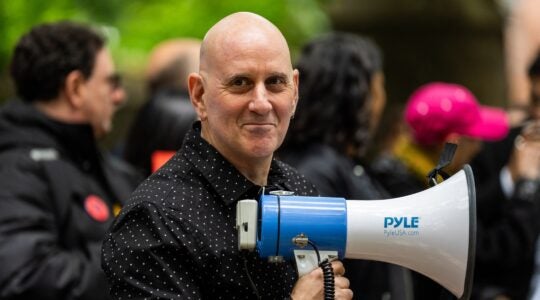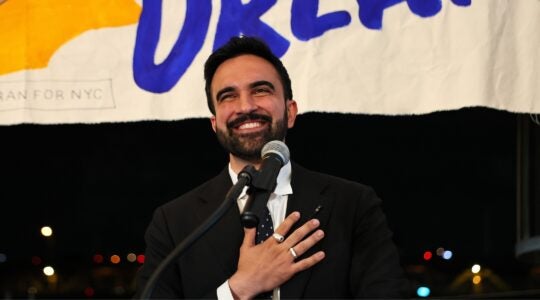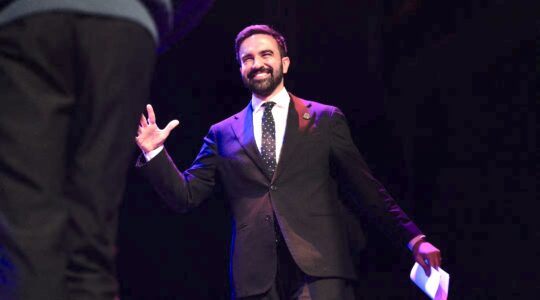Mention the new breast cancer guidelines, and D.J. Schneider Jensen utters a single syllable of disgust. “Uhk!” Like many Jewish women who carry a BRCA genetic mutation or have a personal history of breast cancer, Jensen was appalled by controversial recommendations issued five months ago by the U.S. Preventive Services Task Force of the U.S. Department of Health & Human Services. The new guidelines advise against mammograms until the age of 50, and against teaching self breast exams to women
“My sister would have died. That’s all I have to tell you,” says Jensen, who is 47, and underwent a prophylactic double mastectomy last year after learning that both she and her sister, Cheryl Carter, were carriers of the mutation. If her sister, who is now 49, hadn’t been conducting self-exams, she would not have discovered the tumor that led to learning their family history.
The Task Force guidelines are meant to apply to women who don’t have an increased risk of developing cancer. But with the high cost of tests to check for BRCA mutations, many women may be unaware of their risk status by the age of 40, the traditional year at which American women begin getting mammograms — and the age that many medical organizations, including the American Cancer Society and The American College of Obstetricians and Gynecologists, still recommend that women begin screening.
“There’s that critical gap of women, aged 40 to 50, who may be unaware of being more predisposed to developing breast or ovarian cancer,” says Rochelle Shoretz, executive director and founder of Sharsheret, an organization that serves young Jewish women diagnosed with breast cancer and their families.
These gap years may be of particular concern to Jewish women of Ashkenazi descent, a population with a high incidence of BRCA mutations. One commonly cited statistic holds that 2.5 percent of Ashkenazi Jews carry one of these mutations, which for women indicate a high likelihood of developing breast or ovarian cancer at some point in their lives.
Jensen’s sister found a lump in her right breast while on vacation in Virginia Beach two summers ago. “We were all coming out of the shower, and she said, ‘What’s this?’ recalls Jensen, who works for the Center for Jewish Education in Baltimore. “It was not this monster-huge thing.” But Jensen, who had been conducting her own self-exams on a frequent basis, felt her sister’s lump and knew. “That’s the stuff we’re supposed to be feeling for.”
To date, physicians and organizations say that the Task Force guidelines have not altered many women’s screening plans. Many medical organizations and cancer organizations, including Hadassah and Sharsheret, have released statements taking a stand against these more relaxed guidelines. Insurance companies so far are covering mammograms for women in their 40s. Hadassah is still spreading the word about self-exams. Yet medical professionals and cancer advocates wonder and worry if insurance companies may soon adopt the Task Force guidelines as their own.
Gila Leiter, an obstetrician-gynecologist whose Park Avenue practice includes many Ashkenazi Jewish patients, also noted that the Task Force, which looked at how many lives are saved by mammograms, may have missed an important point: quality of life. “If I pick up an early breast cancer, the person’s life is significantly different than if the cancer is discovered at a later stage. The person may survive, but will go through radical surgery, chemo and radiation.”
Leiter says, “I haven’t modified my guidelines,” and to date, “very few patients are saying, ‘I’m not going for my tests.’ ”
Shoretz of Sharsheret questions the reasoning behind the recommendations, the emphasis on relieving fear and anxiety, on preventing unnecessary biopsies. “Let anxiety be a factor that a woman weighs,” she says.
Still, some Jewish women — and others — welcomed the more relaxed recommendations. The National Breast Cancer Coalition issued its support. Karen Gurwitz, a Manhattan mother of three, was relieved to learn the news, pleased to incorporate her philosophy, “if it ain’t broke, don’t fix it,” into her healthcare. Gurwitz, who is 40, and was raised in Canada by Israeli parents, dislikes the prominence of medical testing in the United States.
Last year, Gurwitz found herself imagining the worst-case scenario after a mammogram, ordered because of something she discovered herself in one breast, showed a tumor in the other breast. She suffered four days of terror before learning the good news: the mass was benign. Though the physician suggested she return in six months, Gurwitz decided to put it off after learning of the more relaxed guidelines. “I don’t need to go through all of that,” again, she said, adding, “Of course, I understand I’m saying this in a place of privilege. If the lump had been something, I would have been thrilled” to have discovered it early.
For those in the high-risk community, however, the guidelines almost uniformly provoke anger. “We are outraged,” says Sue Friedman, executive director, of Facing Our Risk of Cancer Empowered (FORCE), a nonprofit organization that seeks to help those affected by hereditary breast and ovarian cancer. She warns that hereditary risk of breast cancer may be particularly difficult to discern when it hails from the father’s side of the family.
In a blog on her website, Friedman writes that “because of underutilization of genetics experts and risk-assessment tools, many people learn about their high-risk status only after they are diagnosed with breast cancer, detected either by mammogram or breast self-exam.” The entry includes dozens of similar testaments by other members of FORCE.
Caryn Rosenberg, a FORCE member, and New Jersey resident who turns 50 this June, says that she is “very frustrated by the guidelines, especially being a Jewish woman, especially after being diagnosed at the age of 42.”
Rosenberg discovered a tumor during a routine mammogram she requested while undergoing fertility treatments. She thought she’d get the mammogram before becoming pregnant. To this day, she and her husband joke about the embryo they never had a chance to implant, the “Frozen-berg.”
She’d had a mammogram at 40; another one at 41. At 42, the mammogram found an aggressive tumor, already in Stage II. Rosenberg says simply: “If I followed the guidelines, I’d be dead.”
|
Signup for our weekly email newsletter here. Check out the Jewish Week’s Facebook page and become a fan! And follow the Jewish Week on Twitter: start here. |
The New York Jewish Week brings you the stories behind the headlines, keeping you connected to Jewish life in New York. Help sustain the reporting you trust by donating today.




